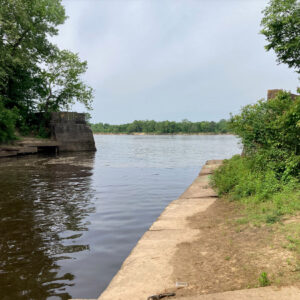calsfoundation@cals.org
Palarm Creek
Palarm Creek arises in rural Faulkner County between Vilonia (Faulkner County) and Holland (Faulkner County) and empties into the Arkansas River near the Pulaski County line. Despite being a relatively small waterway, it has been the site of some significant events in Arkansas history.
From its point of origin, the creek flows westerly until it intersects with Arkansas Highway 36, after which it proceeds in a more southerly direction, crossing U.S. Highway 64 and then turning to the southwest, whereupon several other creeks merge with it before Palarm empties into Lake Conway. At the southern end of the lake, the creek exits from Palarm Creek Dam and again proceeds in a generally southerly direction, crossing through what is now Bell Slough Wildlife Management Area and beneath Interstate 40. It later turns west, running beneath Arkansas Highway 365 and emptying into the Arkansas River at Palarm Park.
The origin of the name Palarm has not been definitively explained. According to Ernie Deane, the name arises from an early French settler, Baptiste Larme, whose home was called Place des Larmes, a name eventually shortened into the present Palarm. However, others have disputed that Baptiste Larme was ever in Arkansas. The name appears as “Pelarm” in some early documents.
Given the lowland area through which the creek traverses, and its intersection with the Arkansas River, the land along Palarm Creek attracted many American settlers even before the land that was to become Arkansas was officially claimed by the United States. The Flanagin and Massengill families, for example, settled near the mouth of the creek around 1778, but that site remained rather sparsely populated, and most settlers later moved to the present-day location of Mayflower (Faulkner County).
Some settlers from eastern Arkansas displaced by the New Madrid Earthquakes of 1811–1812 relocated to central Arkansas, settling in the area of Palarm Creek and Crystal Hill (Pulaski County). At Palarm Park, there exists a historical marker installed during the state’s Centennial Celebration on September 19, 1936, by the Arkansas chapter of the National Society United Daughters of 1812, in honor of James Miller, the first territorial governor of Arkansas, who had purchased land on nearby Crystal Hill in anticipation of the state capital’s relocation from Arkansas Post. Near where Palarm Creek empties into the Arkansas River is the Palarm Bayou Pioneer Cemetery, reportedly the oldest surviving cemetery in Pulaski County, with its earliest documented interment being 1837.
Palarm shows up in some Civil War reports. In September 1864, Colonel Abraham H. Ryan, based in Lewisburg (Conway County), ordered a series of scouting expeditions to determine the location of Confederate troops. One of these, led by Captain James F. Clear of Company D, Third Arkansas Cavalry, entailed a forced march to Palarm Creek, where Clear and some of his men boarded the steamboat Chippewa and sailed to Little Rock (Pulaski County), while others proceeded overland.
Palarm Creek was the site of a major Reconstruction-era skirmish known as the Battle of Palarm during the Brooks-Baxter War. After learning of the departure of the steamboat Hallie, crewed by militiamen loyal to Elisha Baxter, James F. Fagan, who commanded the forces loyal to Joseph Brooks, ordered a force to intercept the boat. Some 200 men under the command of Colonel Jack Brooker raced the boat by train and disembarked at the mouth of Palarm Creek on May 8, 1874. There, they ambushed the steamer, killing a number of the crew and briefly taking control of the ship before it was scuttled by Baxter supporters.
In 1950, work began on the construction of Lake Conway by the Arkansas Game and Fish Commission, which dammed Palarm Creek to create the 6,700-acre reservoir. The lake was dedicated on July 4, 1951, and became a popular recreational site. During the Flood of 2019, the Arkansas River was so inundated that Palarm Creek began flowing backward, reaching such a point that it even started flowing over the dam at Lake Conway.
Palarm Creek has for much of its history been relatively rural. However, the growth of suburbs and bedroom communities around Little Rock led to increased development along the length of the stream. During the 1980s and 1990s, a sign along Palarm Creek was particularly prone to vandalism, with people stealing the letter P so that it read “Alarm Creek.” The creek is a popular fishing site, and there is a boat dock near Palarm Park near the mouth of the creek.
For additional information:
Meriwether, Robert W. “The Brooks-Baxter War and the Battle at Palarm (1874).” Faulkner Facts and Fiddlings 37 (Fall/Winter 1995): 70–73.
———. “The Construction of Lake Conway.” Faulkner Facts and Fiddlings 36 (Spring/Summer 1994): 9–24.
Poe, Deleta Jacqueline. “Lake Conway: Arkansas’ Newest, Finest Playground.” Arkansas Historical Quarterly 12 (Summer 1953): 106–114.
Ross, Margaret Smith. “Squatters Rights, Part II: Crystal Hill–Maumelle–Palarm Settlers Prior to 1814.” Pulaski County Historical Review 4 (September 1956): 33–50.
Staff of the CALS Encyclopedia of Arkansas
 Geography and Geology
Geography and Geology Palarm Creek
Palarm Creek 




Those abutments in the photo are from the railroad; the rails were washed away in the 1927 flood.